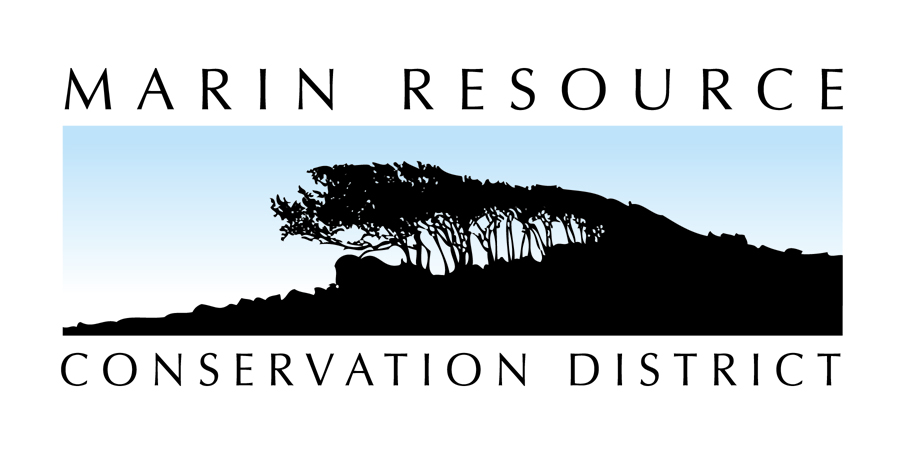Marin RCD Newsletter – June 2024 Content
- The RCD’s COW Program, 15 Years of Conserving Our Watersheds by Gerhard Epke
- Marin RCD’s new Water Quality Program Manager, Gerhard Epke
- Marin RCD’s newest Board Director, David Sherwood
The RCD’s COW Program, 15 Years of Conserving Our Watersheds
written by Gerhard Epke, Water Quality Program Manager, Marin RCD
One of Marin RCD’s longest running and most popular conservation programs is the Conserving Our Watersheds Program (COW), which has resulted in 140 water quality improvements on 40 farms and ranches in West Marin. Since 2008 (the start of the COW program), Tomales Bay water quality data is showing a steady trend toward meeting state water quality standards, with 75% of water monitoring sites being in compliance.
For over 15 years the COW program has been leveraging the RCD’s strengths and partnerships to plan, design, and construct conservation practices throughout the District. Early on, the projects primarily addressed rangeland issues like fencing cattle out of creeks, stopping creek bank erosion and head-cuts in gullies, but recent cycles of the program have expanded beyond ranches to include dairies and horse stables. The impetus for this work comes from the need to protect the State’s identified beneficial uses that are affected by upstream waters in the Tomales Bay watershed such as recreation, habitat, and oysters to name a few. Since the State’s regulatory protections and funding are tied to watershed boundaries, the COW program is inherently watershed-centric. The COW program has largely focused on the Tomales Bay watershed including its tributaries: Walker Creek, Lagunitas Creek and Keys Creek with a recent expansion into Stemple Creek (aka the Estero de San Antonio).
The Marin RCD has been doing this kind of work since its inception in 19591, but the COW program got its start 16 years ago with funding from the State Water Resources Control Board around the same time that the agency began to initiate water quality protections with a Tomales Bay TMDL. Total Maximum Daily Loads or “TMDLs are action plans to restore clean water by defining how much of a pollutant a water body can tolerate and meet water quality standards.”2 The TMDL in Tomales Bay targeted pathogens, in other words microorganisms that can cause human illness. Over the years these protections have expanded and come to include TMDL listings for sediment, nutrients, pathogens and Mercury in West Marin.
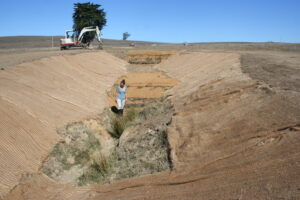
The Conserving Our Watersheds Program implements water quality improvement projects like this one on small family ranches. This photo shows Marin RCD staff monitoring recently installed bio-technical repairs (specifically, fabric reenforced earth-fill) to arrest the erosion within a waterway. See how this repair disappears four years later in the photo below.
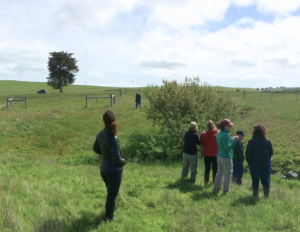
This photo was taken four-years after the installation of a series of bio-technical practices to arrest erosion and improve water quality of this water course. Most projects by Marin RCD and our partners become invisible over the years because we prioritize using bio-technical repairs, so vegetation can heal the land.

A breakdown of funding (blue = grant secured by Marin RCD) and matching dollars (red bars = match secured by land managers, partners or Marin RCD) secured over time to fund the work of the Conserving Our Watersheds Program. The green line is a cumulative count of management practices implemented with these dollars within the Tomales Bay Watershed.
The TMDL listings give the Water Board authority over regulating land use but because the sources are disparate, improvements must be made by voluntary systemic changes. Some of this change involves requiring ranchers and animal facilities to have monitoring plans and permits in place, but it also involves incentives to overcome the financial impediment of making an improvement. Since land and water stewardship is fundamental to most agricultural producers the motivation is there, however a comprehensive fix often runs upwards of $100,000 to complete and is cost prohibitive for a rancher to pay for in a given year. For instance, fencing off a creek from livestock might also involve developing an alternative water supply, or repairing an eroding creek bank might involve engineering designs and permits. This space of matching and supplementing the rancher’s capabilities, is that which the COW program operates in.
One reason the COW program has been so successful for the RCD is that it pulls together partners from other agencies and uses predefined tools and practices. USDA Natural Resources Conservation Service (USDA NRCS) maintains a suite of well-defined conservation practices that address common agricultural problems. For example, conservation practice number 412 is identified as a Grassed Waterway and defined as “a shaped or graded channel that is established with suitable vegetation to convey surface water at a nonerosive velocity using a broad and shallow cross section to a stable outlet”3. If you wanted to build a grassed waterway, a lot of the engineering and decision making for the design has already been worked out, saving on design costs.
A toolkit the COW program uses is the RCD’s programmatic CEQA and permitting process, named the Marin Permit Coordination Program (Marin PCP). Marin RCD created the PCP after polling ranchers on what the blocks and barriers were to implementing conservation practices, which revealed that the duration and cost of permitting was drastically hindering and reducing stewardship work on the land. To streamline the permitting process, the Marin PCP takes 40 of the most commonly used USDA NRCS practices, and in a similarly prescriptive way, predefines where and how one would implement them without causing other collateral damage. This includes requirements to minimize disturbed area, required design considerations for protecting sensitive biological resources, air and water quality.
So how do we know that the program is having a positive impact after all these years? Measuring downstream water quality is indeed giving us that signal, but pulling specific connections between a project and a long-term trend is difficult. The analyses don’t distinguish between human, horse, livestock, wildlife or dog sources. Of the long-term water quality dataset that exist, they all show some level of improvement. The Water Board’s biannual sampling done in conjunction with the Tomales Bay Foundation seems to be getting fewer hotspots5, the California Department of Public Health Shellfish Sanitary reports are showing improvements6, the County’s beach monitoring is showing good levels for swimming7. And yet other metrics are inconclusive such as these Walker and Lagunitas Creek report cards8.
In spite of the progress made improving water quality, or maybe because of it, the COW program can reasonably expect to continue its legacy of land stewardship for at least another 15 years, supporting local agriculture and all of the beneficial uses of our beautiful Marin County watersheds.
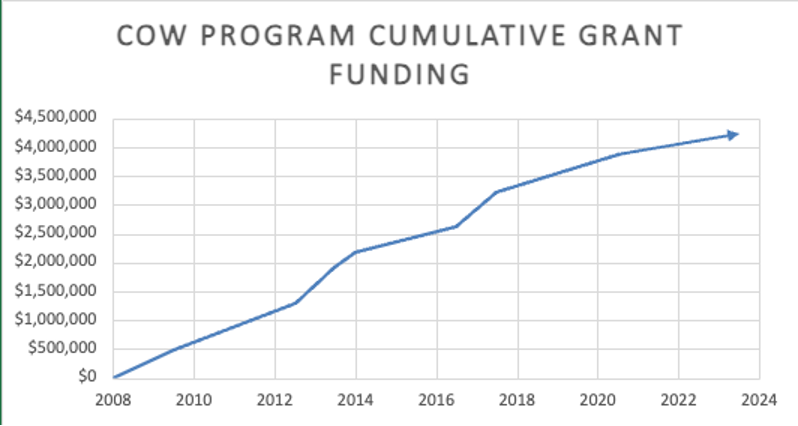
Marin RCD has secure numerous grants to support the Conserving Our Watersheds (COW) Program. Since the inception of the program in 2008, Marin RCD has secure over $4 million dollars to fund stewardship projects that improve and protect water quality.
Footnotes
1 for more history of the RCD in the 50 years leading up to the cow program, visit:
https://www.marinrcd.org/wp/wp-content/uploads/2014/05/A-Half-Century-of-Stewarship.1959-2009.pdf
2 https://www.waterboards.ca.gov/rwqcb2/water_issues/programs/TMDLs/
3 https://www.nrcs.usda.gov/sites/default/files/2022-09/Grassed_Waterway_412_CPS_9_2020.pdf
4 For a complete list of NRCS practices used by the RCD visit: https://www.marinrcd.org/programs/home2/pcp/
5 Tomales Bay Foundation water quality monitoring program:
https://tomalesbayfoundation.org/resources/water-quality-monitoring/
6 Shellfish regulatory page: https://www.cdph.ca.gov/Programs/CEH/DRSEM/Pages/EMB/Shellfish/Shellfish-Program.aspx
7 Marin County Beach Water Quality Reports: https://www.marincounty.org/depts/cd/divisions/environmental-health-services/beach-monitoring
8 2019 Walker and Lagunitas Creek Water Quality Report Cards: https://www.waterboards.ca.gov/about_us/docs/performance_report/fy1819/r2_walkernutrients.pdf;
https://www.waterboards.ca.gov/about_us/docs/performance_report/fy1819/r2_lagunitas_nutrients.pdf
Marin RCD’s new Water Quality Program Manager
As of January, Gerhard Epke (pronounced GER-heart EP-ka) is the new Water Quality Program Manager, taking over the ‘Conserving Our Watersheds Program’ and ‘Permit Coordination Program’ for the Marin RCD. A Marin-native, he comes to the RCD from 10 years working for public works agencies in Marin County—five years in San Anselmo and five at the County. He is immensely pleased to be working in the realm of conservation and in the golden rolling hills of west Marin.
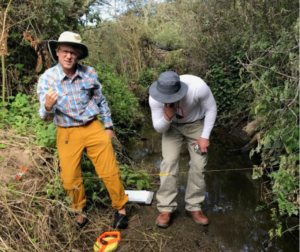
He was born in between the Millennial and Gen X generations, during the year of the goat in Chinese astrology with the Sun in Gemini and Scorpio rising. Gerhard grew up in Marin County and attended local schools and California colleges, his mother was a math teacher and his father was a pastry chef. At UC Santa Cruz in the late 1990’s Gerhard was studying Earth Sciences when two life events influenced his attention towards rivers and freshwater systems.
The first was a summer job with the west Marin based company Outdoor Adventures guiding whitewater rafting trips on the Kern River, in the Southern Sierra Nevada mountains. The second was an engaging hydrology class, and subsequent employment that focused on the flow regimes and water quality of the Pajaro River Watershed in California.
In his 20s, Gerhard attended UC Davis for a Master of Science and shifted his attention to the flow regimes of the Sierra Nevada, comparing the hydrographs of various undammed rivers and the alterations caused by hydroelectric reservoir operation. In particular he looked at the Yuba and American rivers and the shape of the spring snowmelt hydrographs looking for common ground between the environmental and recreational water allotments. Then Gerhard spent some time in Uganda working on water development and sanitation projects, which marked a turning point towards project management and public works, and brought him home to
For the last ten years, he has been raising a family and working in the realms of urban stormwater and flood mitigation in the Ross Valley, which if you have been following the local news has been a somewhat contentious arena. He is a member of the board of Friends of Corte Madera Creek Watershed and also teaches a watershed management class at University of San Francisco, which you could potentially take from him when it’s offered again in 2025.
Marin RCD’s newest Board Director, David Sherwood
I showed up at my first RCD meeting in 2018 at the suggestion of my friend, Sally Gale. I had recently retired from my day job and realized that taking care of my ranch and raising cattle wasn’t quite enough, besides the cows were growing fed up with listening to me. I missed my former collegiate life and wanted to find a way of applying my interests in conservation and ranching more broadly. I realized quite quickly that RCD was an ideal path to follow and I have enjoyed contributing to and learning from the team over the last five years, and I really enjoy all of the people involved.
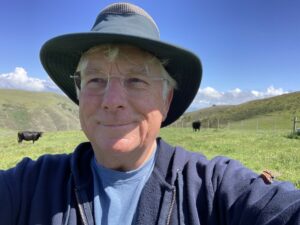
I regularly attended the meetings and became an Associate Director in 2020, and now a board member, and during that time the group has changed significantly: The staff now outnumber the board members by 2:1, a reversal of the ratio when I first arrived. The board no longer consists exclusively of ranchers or farmers, the priorities and funding sources have expanded and evolved, and there’s an even greater sense of urgency in our efforts to protect and restore biodiversity, sequester carbon, and to make agricultural production in the County more sustainable. The expanded staff has not only increased productivity but it has also added a depth of scientific rigor and fresh perspectives from a younger generation. This has created a dynamic and evolving working environment from which we can grow to become even stronger and even better at meeting the needs of our constituents and its funders.
So; it’s the people and the purpose of RCD that attracts me, and the fact that it’s evolving quite rapidly makes it even more interesting.
In terms of my qualifications: I offer significant management, financial and strategic experience. I have three decades of reporting to, or serving on boards. 28 years of ranch ownership in Marin, 15 years of raising high-quality grass-fed beef cattle, and a track record of enthusiastic tree planting (over 600 so far). I have cared for the land in ways which have improved the pasture, soil, and water quality, and protected and created natural habitats for birds, mammals, and insects.
I am grateful to have been appointed a Director and I thank Peter Martinelli for nominating me to serve when he resigned due to health issues. I also thank the board members and Associates for their encouragement, advice, and support.
